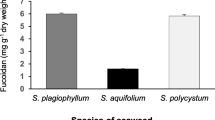Abstract
In this report, we reviewed recent literature on physiologically active substances from sea cucumbers (SCs) and their activities together with results obtained from our study. Preventive properties against lipid metabolism were reported in rats using a whole SC preparation with no particular constituent specified. Administration of the preparation lowered serum and hepatic cholesterol levels and improved the HDL/LDL ratio. These functions may be attributed to the stimulatory effect of the extract on the secretion of cholesterol in feces. Novel fucosylated chondroitin sulfates (FCSs) from Ludwigothurea grisea significantly induced fibroblast growth factor 2-dependent angiogenesis in human umbilical vein endothelial cells (HU-VECs). The proangiogenetic activity seemed attributable to the action of the sulfated fucose branches on the polysaccharide. SCs contain mycosporine-like amino acids (MAAs) that are capable of absorbing UV. A biogenetic precursor of MAAs was first reported in SCs. The anti-proliferative effects of a branched chain fatty acid from a sea cucumber on prostate cancer cells was reported with the activity of 5-lipoxygenase. Glycosphingolipid constituents in SCs have been systematically analyzed over the past ten years. The results showed that the gangliosides in several SCs differed from those of mammals in that a sialic acid of SC gangliosides directly binded to glucose of cerebroside. Neuritogenic activity of the glycosphingolipids was demonstrated in vitro experiments and may lead to the development of therapeutic products for neurological disorders. Our study also showed that sphingoid bases, the hydrolyzed products of glycosphingolipids from SCs, induced significant apoptosis in several tumor cell lines.
Similar content being viewed by others
References
Bandaranayake, W.M., and A.D. Rocher, 1999. Role of secondary metabolites and pigments in the epidermal tissues, ripe ovaries, viscera, gut contents and diet of the sea cucumber Holothuria atra. Marine Biology (Berlin), 133: 163–169.
Bartsch, H., J. Nair, and R. W. Owen, 1999. Dietary polyunsaturated fatty acids and cancers of the breast and colorectum: emerging evidence for their role as risk mod ifiers. Carcinogenesis, 20: 2209–2218.
Dunlap, W.C., and Y. Yamamoto, 1995. Small-molecule antioxidants in marine organisms: antioxidant activity of mycosporine-glycine. Comparative Biochemistry and Physiology, B: Biochemistry and Molecular Biology, 112B: 105–114.
Ghosh, J., and C.E. Myers, 1997. Arachidonic acid stimulates prostate cancer cell growth: critical role of 5-lipoxygenase. Biochemical and Biophysical Research Communications, 235: 418–423.
Minamiguchi, K., K.T. Kitazato, H. Nagase, E. Sasaki, K. Ohwada, et al., 2003. Depolymerized holothurian glycosaminoglycan (DHG), a novel alternative anticoagulant for hemodialysis, is safe and effective in a dog renal failure model. Kidney International, 63: 1548–1555.
Muralidhar, P., P. Radhika, N. Krishna, D.V. Rao, and C.B. Rao, 2003. Sphingolipids from marine organisms: A review. Natural Product Sciences, 9: 117–142.
Rodriguez, E., M. Gonzalez, B. Caride, M. A. Lamas, and M. C. laboada, 2000. Nutritional value of Holothuria forskali protein and effects on serum lipid profile in rats. Journal of Physiology and Biochemistry, 56: 39–43.
Shick, J. M., W. C. Dunlap, B. E. Chalker, A. T. Banaszak, and T.K. Rosenzweig, 1992. Survey of ultraviolet radiation-absorbing mycosporine-like amino acids in organs of coral reef holothuroids. Marine Ecology: Progress Series, 90: 139–148.
Sugawara, T., M. Kinoshita, M. Ohnishi, and T. Miyazawa, 2002. Apoptosis induction by wheat-flour sphingoid bases in DLD-1 human colon cancer cells. Bioscience, Biotechnology, and Biochemistry, 66: 2 228–2 231.
Sugawara, T., M. Kinoshita, M. Ohnishi, J. Nagata, and M. Saito, 2003. Digestion of maize sphingolipids in rats and uptake of sphingadienine by Caco-2 cells. Journal of Nutrition, 133:2777–2782.
Suh, H.-J., H.-W. Lee, and J. Jung, 2003. Mycosporine glycine protects biological systems against photodynamic damage by quenching singlet oxygen with a high efficiency. Photochemistry and Photobiology, 78: 109–113.
Taboada, M.C., M. Gonzalez, and E. Rodriguez, 2003. Value and effects on digestive enzymes and serum lipids of the marine invertebrate Holothuria forskali. Nutrition Research (New York, NY, United States), 23: 1661–1670.
Tanaka, K., S. Nishizono, A. Kase, S. Ogura, M. Kurita, et al., 2003. Effects of dietary black sea cucumber on serum and liver lipid concentrations in rats. Nippon Eiyo, Shokuryo Gakkaishi, 56: 175–179.
Tapon-Bretaudiere, J., D. Chabut, M. Zierer, S. Matou, D. Helley, et al., 2002. A fucosylated chondroitin sulfate from echinoderm modulates in vitro fibroblast growth factor 2-dependent angiogenesis. Molecular Cancer Research, 1: 96–102.
Vieira, R.P., B. Mulloy, and P. A. Mourao, 1991. Structure of a fucose-branched chondroitin sulfate from sea cucumber. Evidence for the presence of 3-O-sulfo-beta-D-glucuronosyl residues. Journal of Biological Chemistry, 266: 13 530–13536.
Yamada, K., 2002. Chemo-pharmaceutical studies on the glycosphingolipid constituents from echinoderm, sea cucumbers, as the medicinal materials. Yakugaku Zasshi, 122: 1133–1143.
Yang, P., P. Collin, T. Madden, D. Chan, B. Sweeney-Gotsch, et al., 2003. Inhibition of proliferation of PC3 cells by the branched-chain fatty acid, 12-methyltetradecanojc acid, is associated with inhibition of 5-lipoxygenase. Prostate, 55. 281–291
Author information
Authors and Affiliations
Corresponding author
Rights and permissions
About this article
Cite this article
Takashi, H., Nobuhiro, Z., Kyoko, Y. et al. Recent advances in researches on physiologically active substances in holothurians. J Ocean Univ. China 4, 193–197 (2005). https://doi.org/10.1007/s11802-005-0031-5
Received:
Accepted:
Issue Date:
DOI: https://doi.org/10.1007/s11802-005-0031-5




